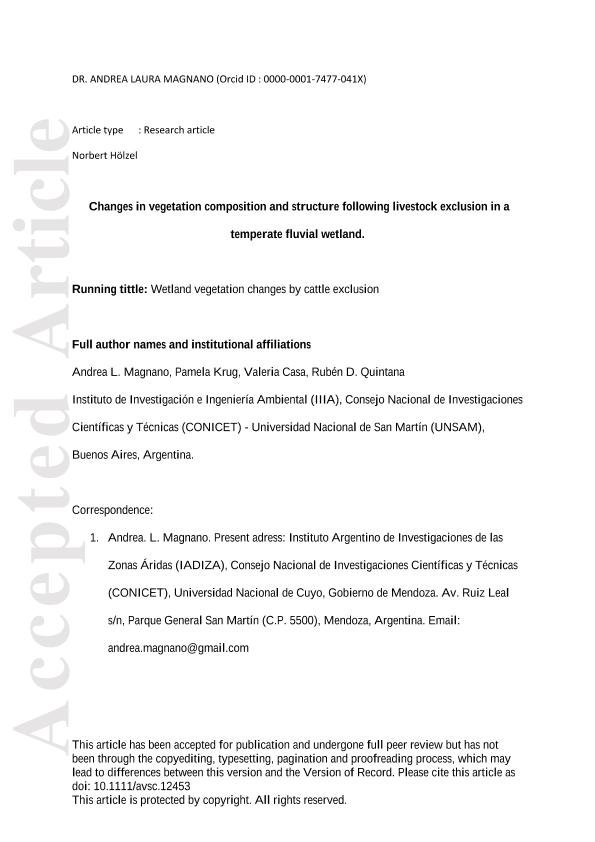Artículo
Changes in vegetation composition and structure following livestock exclusion in a temperate fluvial wetland
Fecha de publicación:
10/2019
Editorial:
Wiley Blackwell Publishing, Inc
Revista:
Applied Vegetation Science
ISSN:
1402-2001
Idioma:
Inglés
Tipo de recurso:
Artículo publicado
Clasificación temática:
Resumen
Questions: Responses of wetland systems to grazing can be highly variable with both positive or negative responses. However, the sustainable use of wetlands for grazing will depend on the management implemented and the resilience of each type of them. In this context, we addressed the question: will the vegetation in the studied wetland be able to recover its structural and functional parameters in the short term after livestock exclusion?. Location: Temperate fluvial wetlands in the middle Delta of the Paraná River, Argentina, South America. Methods: We evaluated the effect of cattle ranching on vegetation composition and diversity by determining changes in species richness and evenness, biomass (green and dry vegetative, and reproductive biomass), and litter content. We also analyzed the changes in biomass of weeds and of species according to their forage quality, toxicity, and growth form. We applied a randomized block design (by topographic position) with repeated measures over time, using livestock exclusion as treatment. Results: After 16 months, livestock exclusion affected vegetation species richness, but did not have a significant effect on diversity due to a slightly compensatory effect of evenness. Species composition differed markedly among treatments over time. There was an increase in dry and green vegetative biomass and litter content after eight months of exclusion, while changes in reproductive biomass occurred later. The increase in these variables was closely related to changes in biomass of species with erect habit and good forage quality. Conclusions: Livestock exclusion increased the forage value for the studied wetland by the development of natural palatable species typical of these environments. This shift in species composition promoted a higher production in biomass in the ungrazed areas. This suggests a remarkable recovery of the structural and functional parameters of the vegetation communities in the short term (two years).
Archivos asociados
Licencia
Identificadores
Colecciones
Articulos (IIIA)
Articulos de INSTITUTO DE INVESTIGACION E INGENIERIA AMBIENTAL
Articulos de INSTITUTO DE INVESTIGACION E INGENIERIA AMBIENTAL
Articulos(IADIZA)
Articulos de INST. ARG DE INVEST. DE LAS ZONAS ARIDAS
Articulos de INST. ARG DE INVEST. DE LAS ZONAS ARIDAS
Citación
Magnano, Andrea Laura; Krug, Cecilia Pamela; Casa, Valeria; Quintana, Ruben Dario; Changes in vegetation composition and structure following livestock exclusion in a temperate fluvial wetland; Wiley Blackwell Publishing, Inc; Applied Vegetation Science; 22; 4; 10-2019; 484-493
Compartir
Altmétricas




